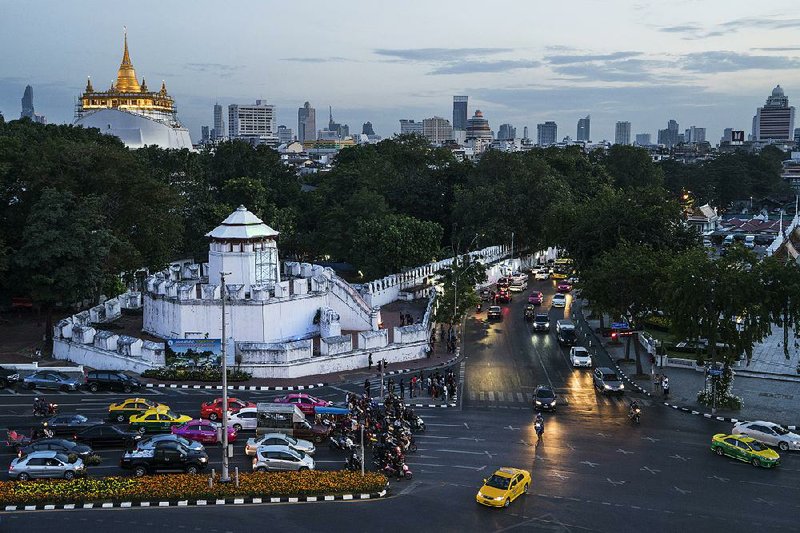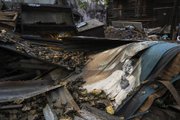BANGKOK -- The thick, white walls of the little fort are smudged and streaked with mold, doing little to keep out the racket and fumes of passing traffic.
Secluded behind them, for the moment at least, is a tiny village -- incongruous among the temples and palaces -- with elaborate wood buildings that have been there for more than a century.
At Fort Mahakan in Bangkok's historic core, a deadline for eviction is approaching at the end of February in a 24-year battle for the fort between the city and the stubborn villagers.
It arrives in the context of a seemingly endless battle for the city's past as canals have been paved over, historic teak houses demolished and entire neighborhoods done away with as a new Bangkok of tall buildings and highways takes their place.
Fort Mahakan is one of the oldest structures in Bangkok, built in the 18th century as one of 14 citadels guarding the city. Only one other fort remains.
The settlement, now reduced to 44 buildings and about 300 residents, has resisted for years a government order to move out and make way for a public park.
In September, the government sent in a crew of demolition workers and pulled down 12 houses in which the residents had agreed to accept compensation and move.
But the other residents, who have banded together in a well-organized bloc, have refused to give up their homes.
The demolition order stems from a royal decree in 1992 to make the ancient Rattanakosin area, which is also home to the Grand Palace and other historic sites, a showpiece of restoration and a magnet for tourists.
With the support of conservationists, academics and civic groups, the residents have proposed a compromise, giving up part of their land and staying on to help manage the site as a "living heritage museum."
"What we want is to stay on this land and develop together with the government," said Tawatchai Woramahakun, 58, the head of a community organization at the fort. "That way everybody wins."
But the Bangkok Metropolitan Administration, or BMA, has brushed aside that proposal, and the city has set a deadline of Feb. 28 for the villagers to surrender their homes for demolition.
"That's the deadline," said Chatri Prakitnonthakan, associate professor of Silpakorn University's faculty of architecture. "There's always a deadline. I'm not sure if this one is real or not."
Deadlines are often negotiating tactics in Thailand, and resistance can prevail, as it has at Fort Mahakan for a quarter of a century. Deadlines have been set and ignored there in the past.
But some supporters of the villagers worry that the current military government won't back away, and some residents seem resigned to leaving.
"I will ask for their sympathy," said Sarayut Nilbai, 50, who repairs bird cages for a living and said his father and grandfather had lived there before him.
"I'll have to spend a lot of money to move out, and we'll have to start all over again," he said. "I have no plans for the future."
His neighbor, Paiboon Tularak, 65, who makes bird cages and raises zebra doves, seems to have had enough after decades of resistance and now says, "What's the use?"
"They'll insist we have to leave," he said. "It's time. They don't think we are important here."
For some observers, the struggle over the fate of the villagers has a broader significance. It is a clash over the character of historic sites and the meaning of preservation.
"The government's definition of history is palaces and temples," said Chatri, the architect. "The community is not part of history, by the government's definition."
He said it was also a question of class, with people in poor communities forced by eviction or the cost of living to move out of the city center and to face a long commute to their jobs.
"All these small communities will be turned into areas to serve middle-class people, high-class people, tourists," Chatri said. "It won't be a city for everyone. For middle-class people like us, we want people to clear the garbage, sweep the streets. If you don't allow these people to live in the city, it's not fair."
The renewed pressure on Fort Mahakan coincides with a broad campaign by the military government to instill order in this unruly city, clearing the sidewalks of the vendors and food stalls that give Bangkok its character and color.
The government has pushed the clamorous profusion of flower vendors off the sidewalks around the city's famous flower market.
As of October, in the latest reported statistics, the government said it had evicted 19,678 vendors from 223 public areas in 42 districts.
"It's the mentality of a military government," Chatri said, "discipline, rules, order. Clear out every messy thing."
The government is also pushing forward with a plan for a promenade along the bank of the Chao Phraya River that it says will displace 309 families in 12 communities of riverfront homes and shanties.
One of the most engaged and knowledgeable observers is Michael Herzfeld, professor of the social sciences in the anthropology department at Harvard, who has just published a book about Fort Mahakan called Siege of the Spirits: Community and Polity in Bangkok.
"I think the BMA is simply operating on a model of clean lines and no people," he said. "They forget what a city is for. City life has to be somewhat messy to be bearable."
The city planners, he said, "are living in a kind of world of bourgeois imagination that has little to do with reality."
That has happened in the sterile cityscape of Singapore, once one of the most exciting cities in Asia, where vendors have been swept off the streets and grouped together in enclosed "hawker centers."
Herzfeld called this approach "spatial cleansing."
The villagers at Fort Mahakan have worked to show that they can keep their area clean and organized, and have put up signs in Thai and English at the oldest and most historic houses.
A sign on one wood house says that it is the site of the first performances of a traditional theater form called likay but that its residents now sell fish maw soup.
One building called Gold Melting House is the site of a former business that melted tiny amounts of gold into bars. Another housed a water-delivery business.
Others are designated Earthenware House, House of Music, Palace Police and Thai Massage, describing trades that were lodged there.
Just behind those remnants of the past is a scene of what could become the future at Fort Mahakan.
In a vacant lot under the trees lies a jumble of boards, tin roofing and chunks of concrete where a wrecking crew had already done its work on 12 of the houses in September.
SundayMonday on 01/08/2017

